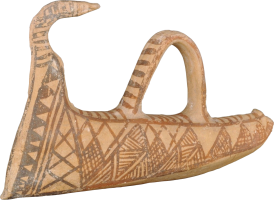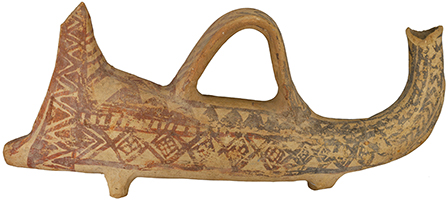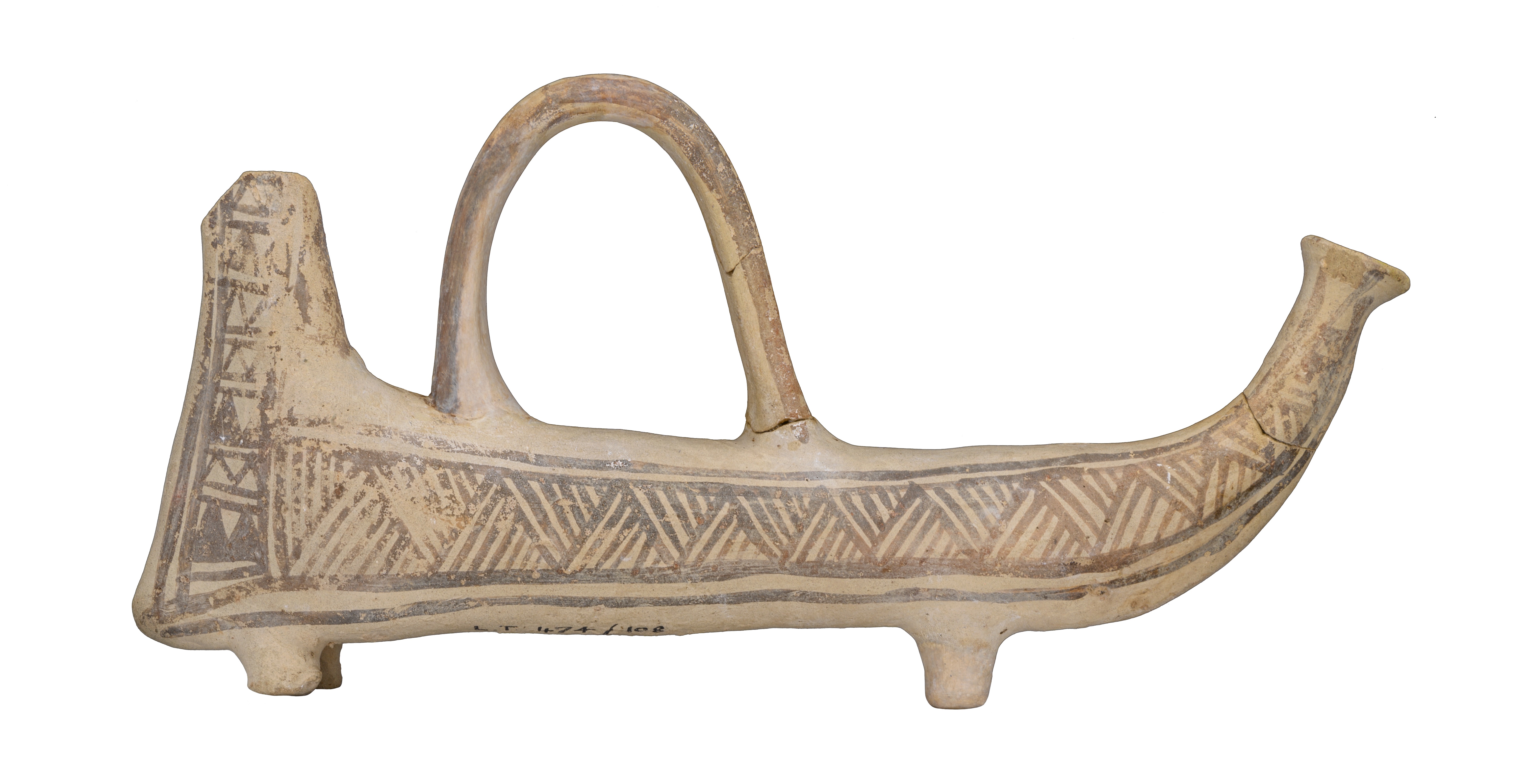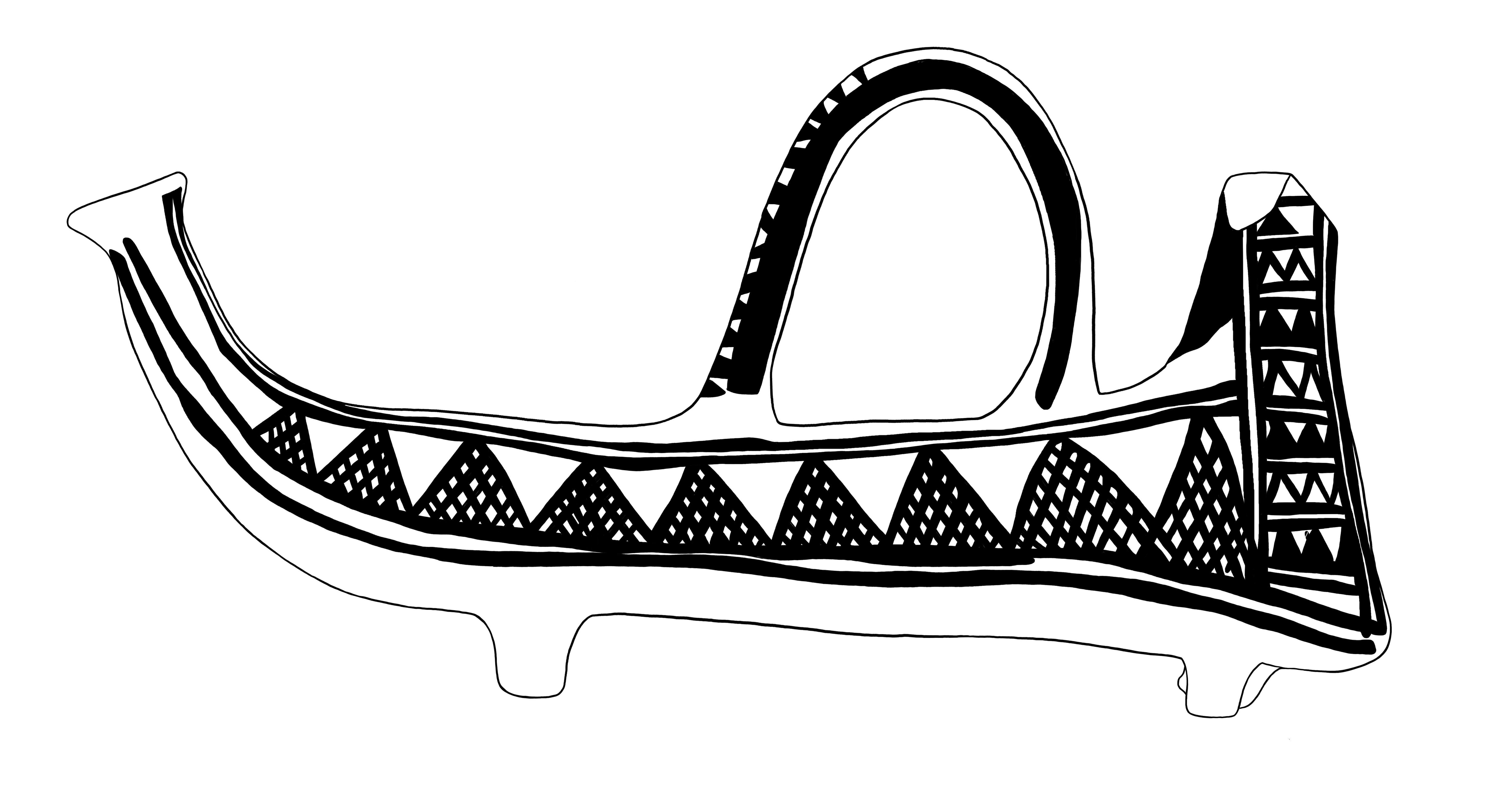Proto-White Painted ware basket handle askos with three short legs and a spout with a flaring rim. Flat hull, triangular bow with a slightly inward leaning stempost. The sternpost curves more gradually compared to the previous exemplar. Vertical lattice stempost decoration comprised of narrow panels filled with short rows of alternating solid and plain triangles. The remaining elements appear to be purely ornamental. One side has a row of latticed triangles framed with horizontal lines, while the other has hatched triangles framed with horizontal lines.
Ship-shaped askos
C14
LC IIIB (1100-1050 B.C.) type but in an early CGI context (1050-1000)
Lapithos tomb 474
L: 28 cm; H: 13 cm
Proto-White Painted ware ship-shaped askos/rhyton with legs and a basket handle. Brownish paint
Nicosia Museum. L.T.474.108 (field number: 1411)
Basch 1987: 149-50, nos. 313-16; Diakou 2013: 179-80, 951, no. 107; Knapp 2019: 143-144; Pieridou 1965: 87, no. 108; Wachsmann 1998: 151, 187, figs. 7.48A-B, 8.47; Wedde 1999b: 468, pl. XCI: -D5 Tomb 474: Diakou 2013: 141-243, 916-963 (appendix); Pieridou 1965
Cypriot askoi of the EIA come in a wide variety of shapes (bird, fish, zoomorphic, and other miscellaneous forms) yet all share a few main elements in common: they are closed shapes, have a basket handle, and a cylindrical spout that is often funnel shaped (Kourou 1997: 89). The ship-shaped askoi are decorated with geometric motifs that are familiar to Proto-White Painted ware. Some of the painted decoration can be nonetheless plausibly identified as depicting actual ship elements. Two of the models come from Lapithos while one is of unknown provenance. Given that it is very similar to the others it is quite likely to come from Lapithos as well. **Lapithos Tomb 474:** Chamber tomb 474 has a long and narrow dromos (0.70-0.85 x 4.80 x 2.45 m deep) and a quadrangular chamber (2.70-3 x 2.05 x 1.15 m high). The descent was made by an irregular ramp (1.7 m long) at the end of which there is a step (0.3 m high) leading into the chamber. The chamber was blocked by a rubble wall below which a burial was found. The skeleton was laid in an extended position on a horizontal platform made of earth fill, with the head toward the chamber to the south and the arms close to the side. Its skull and feet were missing. The only gift accompanying the skeleton was a single oinochoe placed over the left upper arm. The excavators have suggested that this represents a human sacrifice. Inside the chamber were found a total of four burials, their heads all pointing north . These include a woman and a girl east of the center and two men (?),one along the west wall and one west of the center. Thanks to the large size of the chamber, earlier burials were not disturbed during the tomb's reopening. The child and female burials are dated to early CGI, while the two male burials to CG II. There were also some earlier Proto-White Painted vessels dating to LC III.
T.474 is considered as one of the richest tombs from the Upper Geometric cemetery along with T. 480 and T. 485. Along with the other two tombs, it has the largest chamber floor area, including estimated area per burial, as well as the largest amount of pottery. The vessel assemblage is enormous, totaling 283 pieces of which White Painted I (197) predominates, covering various shapes such as bowls, jugs, juglets and especially amphorae. Out of the 11 tombs that have produced metal artifacts, it is one of only three to have gold, and contains the largest overall amount of metal objects and the largest number of bronze objects. The tomb also has the largest collection of ceremonial vessels, including two tripod stands, six bird-shaped askoi, one kernos, one boat shaped askos and one animal-shaped vessel. Finally, it is one of three burials to have imports, notably 2 Levantine bichrome flasks (Diakou 2013: 640-43). The stone mortar is considered to be an LC III antique. It is notable that the earliest burials of the child and woman are particularly rich, each given a pair of gold earrings. The vast majority of the ceremonial vessels , including the boat shaped askos, were also associated with the child.
Aside from the addition of legs and a basket handle characteristic of askoi in general, there is no reason to suspect that the elongated flat shape of the hull is a distortion to suit the medium, since much squatter, rounder shapes are common for the zoomorphic askoi. In other words, a beamy crescentic vessel could be easily rendered but the artist ostensibly intended to highlight the distinctive slender hull of an oared galley.
The object was re-studied by the author in 2024, at which time it was found with its previously mended parts broken in the storeroom of the museum. The mended part of the handle is now missing, and must have been lost sometime post-excavation, since old photos of the askos still have it. The 3D model of the askos was completed after restoration, but the paint of the handle was not reproduced with the exact painted decoration of the original.
Basch, L. 1987. Le musée imaginaire de la marine antique. Athens: Institut Hellénique pour la preservation de la tradition nautique.
Diakou, S. 2013. “Lapithos: the Upper Geometric cemetery.” PhD dissertation, Bryn Mawr College, US.
Knapp, A. B. 2018. Seafaring and Seafarers in the Bronze Age Eastern Mediterranean. Leiden: Sidestone Press.
Pieridou, A. 1965. “An early Cypro-Geometric tomb at Lapethos.” RDAC: 74-111.
Wachsmann, S. 1998. Seagoing Ships & Seamanship in the Bronze Age Levant. College Station, TX: Texas A&M University Press.
Wedde, M. 1999b. “War at Sea: The Mycenaean and Early Iron Age Oared Galley,” in R. Laffineur (ed.) Polemos: Le context guerrier en Égée à l’âge du bronze. Actes de la 7e Rencontre égéenne internationale, Université de Liège, 14–17 Avril 1998. Aegaeum 19. Liège: Université de Liège, pp. 465–427.








